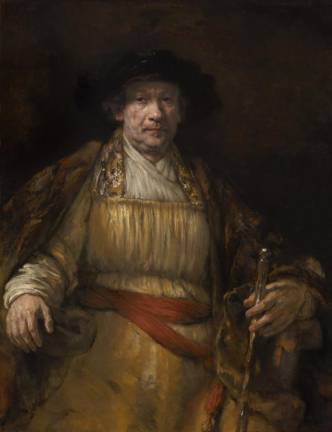Meet a Masterpiece
Rembrandt's Self-Portrait at The Frick Collection Offers a Journey of Discovery

There's something transportive about standing in front of a great work of art and experiencing its presence, impact, scope, details and nuances. It may have been some time since you've had the chance to see a favorite work – or maybe you've never seen it in person. With current museum closures, it may be a while till the next time. Still, art that moves us, stays with us.
Rembrandt's Self-Portrait from 1658, a masterpiece of the Frick Collection, is a New York treasure. While the artist produced scores of portraits of himself throughout his career, the Frick's is the largest and one of the most compelling. In it, Rembrandt is wrapped in sumptuous golden robes looking commandingly down at the viewer. He holds a maulstick (a painting tool used to steady the hand) like a scepter, as though he's proclaimed himself the king of painters. For his time and place, it wouldn't be far from the truth.
In 1606, Rembrandt Harmenszoon van Rijn (son of Harmen, from the Rhine) was born into the family of a miller and his wife. He was the eighth or ninth child, and the brightest and most promising. His parents decided that it he was the one who should be given the chance to attend the university. He immersed himself in Latin and classics, but quickly fell in love with painting. After a few months, he left school to become apprenticed to a major artist in a minor city, Leiden.
An Artistic Explorer
Bigger ambitions beckoned, and soon Rembrandt moved to Amsterdam, where his astonishing skill brought him important commissions, success, wealth, a beautiful young wife and a fine house. Amsterdam was a hotbed of art in the 1600s. It was a busy trading hub, populated by a newly rich merchant class. Unlike their predecessors, who spent their wealth on expanses of land, they lived in city homes. And they loved to decorate them with opulent, beautiful things, including paintings of themselves.
In that world, Rembrandt could have achieved a comfortable respect churning out flattering pictures of ship captains, politicians and their families. But Rembrandt was an artistic explorer, keen to discover the capacity of paint, the effects of light, and, above all, the breadth of the human soul. His interest was the inner life.
In Rembrandt's paintings, piercing light floods the darkness. More than a tool for pictorial drama, it can be read also as a metaphor for the kinds of times we all pass through. The psychological observations he couldn't portray on paying customers – pride, insecurity, contemplation, passion, weariness, resignation and love – found expression in his self portraits.
An Artist in Command
By 1658, when he painted this piece, Rembrandt had known fame, success, domestic comfort, the love of family, but also the deaths of his wife and three of their children, the loss of his home, bankruptcy and the shunning of a society that had once hailed him. His misfortunes, to some extent freed him to paint this triumphant portrait. No longer wealthy, but also no longer beholden to patrons, he forged his own creative path and produced some of the most original, astonishing, enthralling paintings in the history of art.
In the Frick portrait, Rembrandt's imperious glance seems to challenge the viewer. In other self portraits, Rembrandt looks vulnerable, weary, or resigned. Here, he announces himself, confident and proud, an artist in command. And then he proves it in paint. As your eyes travel across the almost glowing golden robes (he was known to mix ground glass into his paints to make them lustrous) try to count the layers of brushstrokes that define each swath of fabric. It's not possible. Nor is it possible to tell how speckles of highlights somehow become shimmering metallic threads on his collar. The maulstick he holds is barely painted at all. Just a few daubs of white somehow perfectly describe the luster of warm, worn wood.
The Eyes of a Master
The greatest mastery is revealed when you look into Rembrandt's face. There's a palpable presence here of a man who has lived – his experiences expressed in the veils of light and dark that define shadows around his eyes, or soft flesh around the chin. A splotch of red amidst a thousand other blotches of pink, grey, brown or white somehow brings cheeks to life. And then two tiny points of white connect the eyes of the artist to those of the viewer. The gaze is personal, intimate, and returned.
What does it look like he might say? How would you respond? To me, he seems to say "Know thyself." For Rembrandt it was his life's work, a journey he invites you to witness, consider and even join.
The Frick Collection, 1 East 70th St
Currently closed, but offering an online virtual tour
https://www.frick.org/visit/virtual_tour
The psychological observations he couldn't portray on paying customers – pride, insecurity, contemplation, passion, weariness, resignation and love – found expression in his self portraits.